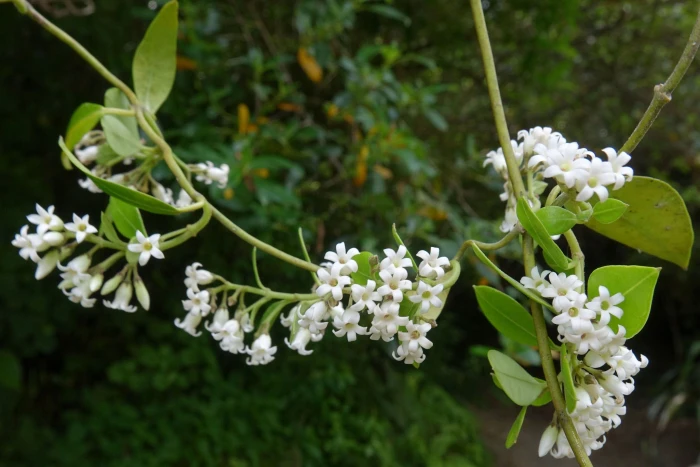New Zealand Jasmine
(Parsonsia heterophylla)
New Zealand Jasmine (Parsonsia heterophylla)
/
/

John Barkla
CC BY 4.0
Image By:
John Barkla
Recorded By:
Copyright:
CC BY 4.0
Copyright Notice:
Photo by: John Barkla | License Type: CC BY 4.0 | License URL: http://creativecommons.org/licenses/by/4.0/ | Rights Holder: John Barkla | Publisher: iNaturalist | Date Created: 2019-11-29T09:35:54-08:00 |

























Estimated Native Range
Climate Requirements for Rockford, Illinois
| This Plant | Your Site | Plant Suitability for Your Location | ||
|---|---|---|---|---|
| • Precipitation | 22" - 185" | 36" | Aquatic | Aquatic |
| • High Temp. | 60°F - 82°F | 85°F | Your summers may be too hot for this plant. | Too hot |
| • Low Temp. | 23°F - 57°F | 11°F | Your winter temperatures may be too cold for this plant | Too cold |
This plant should grow well at your location with about N inches per year (Y minutes per month) of irrigation.
Summary
Parsonsia heterophylla, commonly known as New Zealand Jasmine or Kaihua, is a climbing vine that is endemic to New Zealand, where it thrives in lowland and low montane forests, particularly at forest margins, clearings, and along stream banks. It can grow up to 33 feet tall, with opposite, shiny dark green leaves that are variable in shape. The plant produces clusters of small, white, fragrant, tubular flowers during spring and summer, which are particularly attractive at night when they are pollinated by moths. The flowers’ sweet scent is a notable feature, and they are followed by long, slender seed pods. Kaihua’s nectar is also a food source for the New Zealand bellbird.
New Zealand Jasmine is valued for its ornamental appeal, with its twining habit and fragrant flowers making it a popular choice for trellises, fences, and pergolas in gardens. It is relatively easy to maintain, requiring moderate watering and thriving in well-drained soils with rich organic matter. It prefers a position in full sun to part shade. While generally disease-free, it can be susceptible to root rot if overwatered or planted in poorly drained soils. Gardeners should be aware that Parsonsia heterophylla can become quite vigorous and may require regular pruning to keep it under control.CC BY-SA 4.0
New Zealand Jasmine is valued for its ornamental appeal, with its twining habit and fragrant flowers making it a popular choice for trellises, fences, and pergolas in gardens. It is relatively easy to maintain, requiring moderate watering and thriving in well-drained soils with rich organic matter. It prefers a position in full sun to part shade. While generally disease-free, it can be susceptible to root rot if overwatered or planted in poorly drained soils. Gardeners should be aware that Parsonsia heterophylla can become quite vigorous and may require regular pruning to keep it under control.CC BY-SA 4.0
Plant Description
- Plant Type: Vine
- Height: 10-30 feet
- Width: 3-6 feet
- Growth Rate: Slow
- Flower Color: Yellow
- Flowering Season: Summer
- Leaf Retention: Evergreen
Growth Requirements
- Sun: Part Shade, Full Shade
- Water: Medium
- Drainage: Medium
Common Uses
Bird Garden, Butterfly Garden, Fragrant, Low Maintenance
Natural Habitat
Thrives in lowland and low montane forests, particularly at forest margins, clearings, and along stream banks
Other Names
Common Names: Kaihua, Akakiore
Scientific Names: Parsonsia heterophylla, Parsonsia albiflora, Parsonsia macrocarpa, Periploca heterophylla, Periploca heterophylla
GBIF Accepted Name: Parsonsia heterophylla